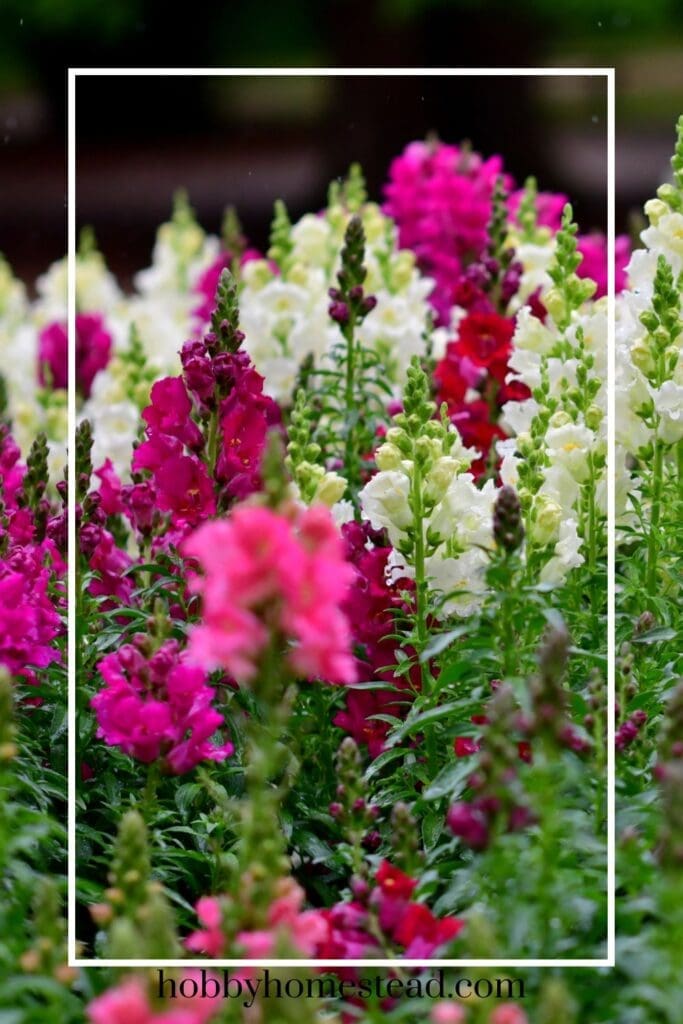Last updated on April 25th, 2025 at 09:57 am
8 Reasons to Add Snapdragons to Your Garden is more than just a catchy title—it’s a great idea for any gardener looking to add vibrant blooms and long-lasting color to their garden beds or outdoor spaces. Whether you’re planting snapdragon seeds for the first time or picking up young plants from a garden center, these charming flowers are easy to grow, attract pollinators, and even improve soil conditions. Plus, their ability to thrive in cooler temperatures and bounce back after a light frost makes them a favorite in spring gardens and cottage gardens alike.
Ready to discover why snapdragons are a must-have? Let’s dive in!
Snapdragons (Antirrhinum majus), also known as “dragon’s mouth” due to the unique shape of the individual flower heads, are a great addition to any garden. Whether you’re planting them in flower beds, garden beds, or container-grown snapdragons in outdoor spaces, these beautiful blooms bring color and charm to your landscape.

What is a Snapdragon?
The snapdragon (Antirrhinum majus) is one of those old-fashioned flowers that only gets better with time. If you haven’t shopped around for snapdragon plants or snapdragon seeds recently, you’ll be amazed at what the latest hybrids have to offer, including a wider array of colors, growth habits, and height options, ranging from just a few inches to several feet. You can even find trailing snapdragons perfect for hanging baskets and window boxes.
What hasn’t changed over the years is the snapdragon’s affinity for cool weather, which is why it continues to be a mainstay for adding bold pops of color to the garden in early spring and early fall. Today, you can also find heat-tolerant snapdragon varieties that will bloom like mad all the way until the first frost, even during the hottest days of summer.
8 Reasons to Add Snapdragons to Your Garden
If you’ve never grown them before, here are eight reasons why snapdragon plants deserve a place in your spring garden this year.
1. Bright Snapdragon Flowers for a Long Bloom Season
Snapdragons provide early spring blooms and continue flowering well into early summer and sometimes early fall if cared for properly. They thrive in cooler temperatures, making them perfect for extending the bloom season before the summer heat kicks in.
2. They Attract Beneficial Pollinators
If you have a vegetable garden, adding snapdragons is a great way to attract bees, butterflies, and even hummingbirds. These pollinators help improve the yield of nearby fruits and vegetables.
3. Snapdragons Are Easy to Grow from Seed
Starting snapdragon seeds indoors in cell trays during late winter or early spring ensures best results when transplanting them outdoors after the last frost date. The tiny seeds germinate best in well-drained soil with plenty of organic matter.

4. They Make Excellent Cut Flowers
Snapdragons are a favorite for cut flower arrangements because of their vibrant blooms and long-lasting freshness. Tall snapdragons make striking centerpieces, while shorter varieties work well in mixed bouquets.
5. They Can Return Next Year in Some Climates
Although considered short-lived perennials, snap dragons can overwinter in milder climates, returning next year from their seed pods or self-seeding naturally in the right soil conditions. In hot summers, they may act more like short-lived plants, but replanting is easy!
6. Snapdragons Improve Garden Soil
Their deep root system helps with soil aeration, especially in sandy soil or compacted ground. Planting them in partially shaded locations or full sun with well-draining soil will promote healthy growth.
7. They Help Control Aphids Naturally
Aphids are a significant problem for many plants, but snapdragon plants attract ladybugs, which feed on aphids and other garden pests. This natural pest control reduces the use of pesticides in your garden.
8. They’re Low Maintenance and Adaptable
Snapdragons tolerate cool weather and light frost, making them hardy in changing seasons. They require about an inch of water per week and can withstand times of no rainfall once established. Pruning spent flowers at the base of the plant encourages new growth and new stems for extended blooming.

Caring for Your Snapdragons
To keep your young snapdragons thriving, plant them in well-draining soil and water when the top inch of soil feels dry. Watch out for common name diseases like powdery mildew, downy mildew, and rust fungus, especially in humid conditions. Snapdragon rust and fungal disease can be minimized by providing good air circulation and avoiding overhead watering. If you see fungal leaf spots, remove affected leaves to prevent spreading. Epsom salt can be added to soil to promote lush foliage.
Varieties of Snapdragons
Snapdragons come in a range of sizes and types, from tall snapdragons that reach several feet in height to trailing snapdragons perfect for hanging baskets. There are also dwarf varieties that stay compact, making them ideal for small spaces and borders.
Planting Snapdragons
For best results, plant snapdragons in late winter or early spring after the last frost date. They thrive in full sun but can tolerate a partially shaded location in hotter climates. Ensure they are in well-drained soil enriched with organic matter to support healthy growth.
Growing Snapdragons from Seed
Snapdragons are easy to grow from seed. Start snapdragon seeds indoors in cell trays about 8-10 weeks before the last frost date. Once the snapdragon seedlings develop sets of true leaves, they can be transplanted outdoors in garden beds or larger containers.
Planting Snapdragons in Containers
Container-grown snapdragons are a great choice for patios, balconies, and outdoor spaces. Use a larger container with well-draining soil and ensure the crown of the plant is not buried too deeply. Water regularly, especially during hot summers, to keep the plants thriving.
Final Thoughts
Whether you’re growing snapdragon seedlings from stem cuttings or buying young plants from garden centers, snapdragons are a great addition to any cottage garden or spring garden. Their beautiful blooms, pollinator-attracting benefits, and ability to thrive in cool temperatures make them a must-have for every gardener. Give them a try this year, and enjoy the bright snapdragon flowers all season long.
References
The Spruce. Snapdragons: Plant Care & Growing Guide.


